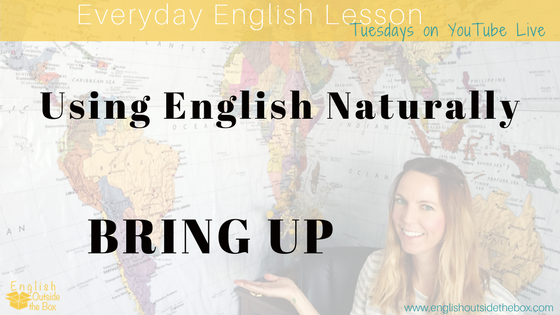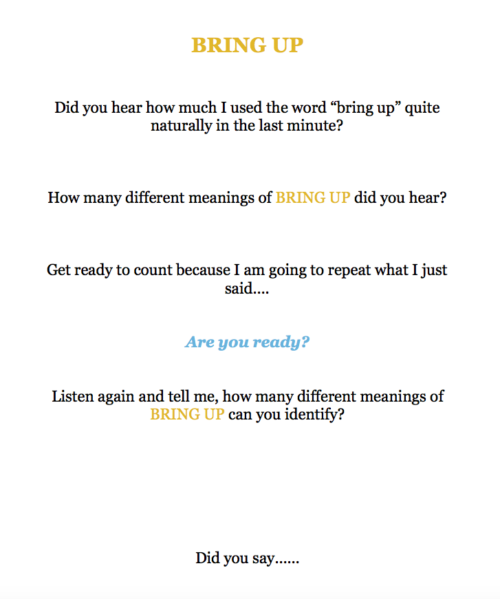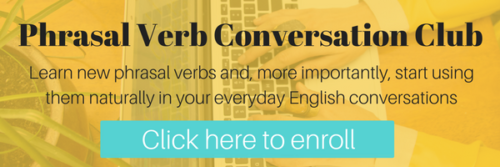
Using English Naturally: Bring Up
Sounding more natural in English, and using English more naturally is easier than you think when you have the right tools and resources. It shouldn’t be a surprise that in order to sound and use more natural English, you need to learn in a natural way. The most natural way to learn English is in (or with) context. By learning in context, it’ll be easier for you to remember new phrases, vocabulary, and grammar structures later in your own conversations.
Today’s live lesson (and your replay below) introduced various meanings and uses of the phrasal verb ‘bring up’ in context. Additionally, I shared with you more ways to practice, learn, remember, and use more phrasal verbs (and expressions) naturally in English.
So, in today’s lesson you’re going to learn:
- various meanings of the phrasal verb ‘bring up‘
- how to learn phrasal verbs naturally
- how to speak and use natural English
Using English Naturally: Bring Up
I wanted to bring up this idea about using English naturally with you today because I know how important it is for you to improve your English skills and speak more confidently! I’ve brought it up before and hey – I’ll probably bring it up again, but it’s really important so I am sure you won’t mind. I was brought up in a way to always work hard to achieve my goals. My parents brought me up to be hard working, dedicated, and motivated to accomplish what I want. You can see this dedication in my business, which is English Outside the Box. Yes – this video, blog post, and English lesson is all part of my job and online English business! 🙂 By the way, did you see what I brought up on the screen in my live lesson? I brought up a word document on the screen that looked like this:

As you can see, I gave you (and the live students watching) an opportunity to hear the phrasal verb ‘bring up’, to try and identify the meaning based on the context provided, and allowed you time to think (in English) about the contextual situation that you heard.
Then I provided you with the information: the definitions, and I elaborated on the meanings of each of the 3 ways I used ‘bring up.’
Bring Up
- to mention something for discussion: “I want to bring up the idea of natural English.”
- to teach, take care of, and to raise a child: “I was brought up in a way to always work hard.”
- to cause something to appear on the computer screen: “I brought this PDF up for you to see.”
The way I presented this information for you were the first few steps to using more natural English.
If you followed these first few steps that I presented, you will remember how to use BRING UP more naturally in your next conversation.
If you did not follow the steps, then you most likely will forget this new language along with the other English you’ve learned.
What are the steps to use natural English more effectively?
Step 1: listen to new language naturally in context first to hear how natural English is used
Step 2: write down the new vocabulary that you heard (or whatever the target language is: grammar, phrasal verbs, etc..)
Step 3: think about this new language/vocabulary in context to try and identify the meanings
Step 4: read the transcript/article to check understanding and see how natural English is used
Step 5: review the true definitions to ensure accuracy
Step 6: read more sentence examples and contextual situations
Step 7: apply it to your own life, think of how/where can you use it
Step 8: start using it in your own daily conversations!
Most students don’t do these last two steps and skip the learning process where they can apply it to their own life. This is why many students forget new language and vocabulary that they’ve learned.
Why?
They forget because it feels irrelevant and impersonal to them. They don’t think about how they’ll use it, so they forget it!
Does this happen to you? Do you often forget the new language and vocabulary that you’ve learned?
Then you need to start completing the 7 steps when you are studying English.
You need to start learning more natural English in context. You need to hear it, and you need to see it (read it). You need to learn the definitions and see examples, and you need to learn how to apply it to your own life.
You also need to start using it in conversations and increasing your speaking opportunities.
I have resources for these 7 steps, and I can help guide you through these 7 steps in my Phrasal Verb Conversation Club! I can connect you to more speaking opportunities with conversation partners, daily tasks, and group conversation lessons!
The conversation club is designed to help you learn how to use more natural English and be a more confident English speaker. I designed the weekly curriculum to help you learn, remember, and use more phrasal verbs and English expressions.
I want to invite you to join the conversation club today, where you are guaranteed to start speaking more English. You will get weekly resources to help you learn new phrasal verbs, practice using them, videos to help improve your pronunciation, PDFs to support your learning and more!
When you “click here to enroll” you will be able to review the curriculum, more information, and details, as well as see what other students have had to say!
Practice Makes Perfect
Join the conversation club today and start reviewing this phrasal verb, bring up, plus 10 more! We’ll review the examples, meanings, and more contextual situations.
I’ll see you there!
Until then,
Happy Studying! ♥
The Conversation Club will provide you with 6 group conversation calls to practice with a real teacher and a group message community to connect with other members.
You will also get weekly English lessons to help your vocabulary, listening, reading, pronunciation, and more!
Try the Club for 1 week, free! Join the 1-week free trial here.

